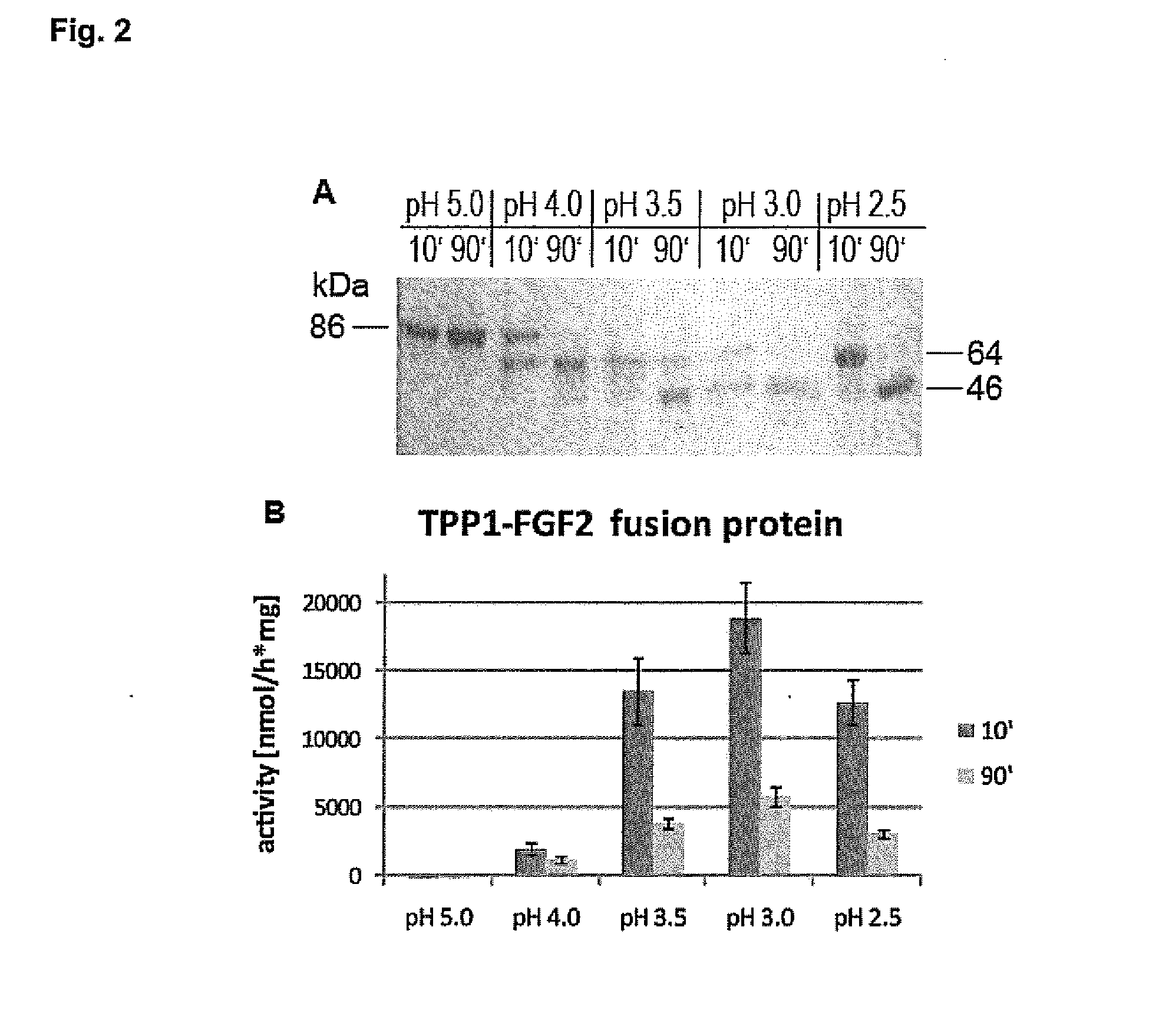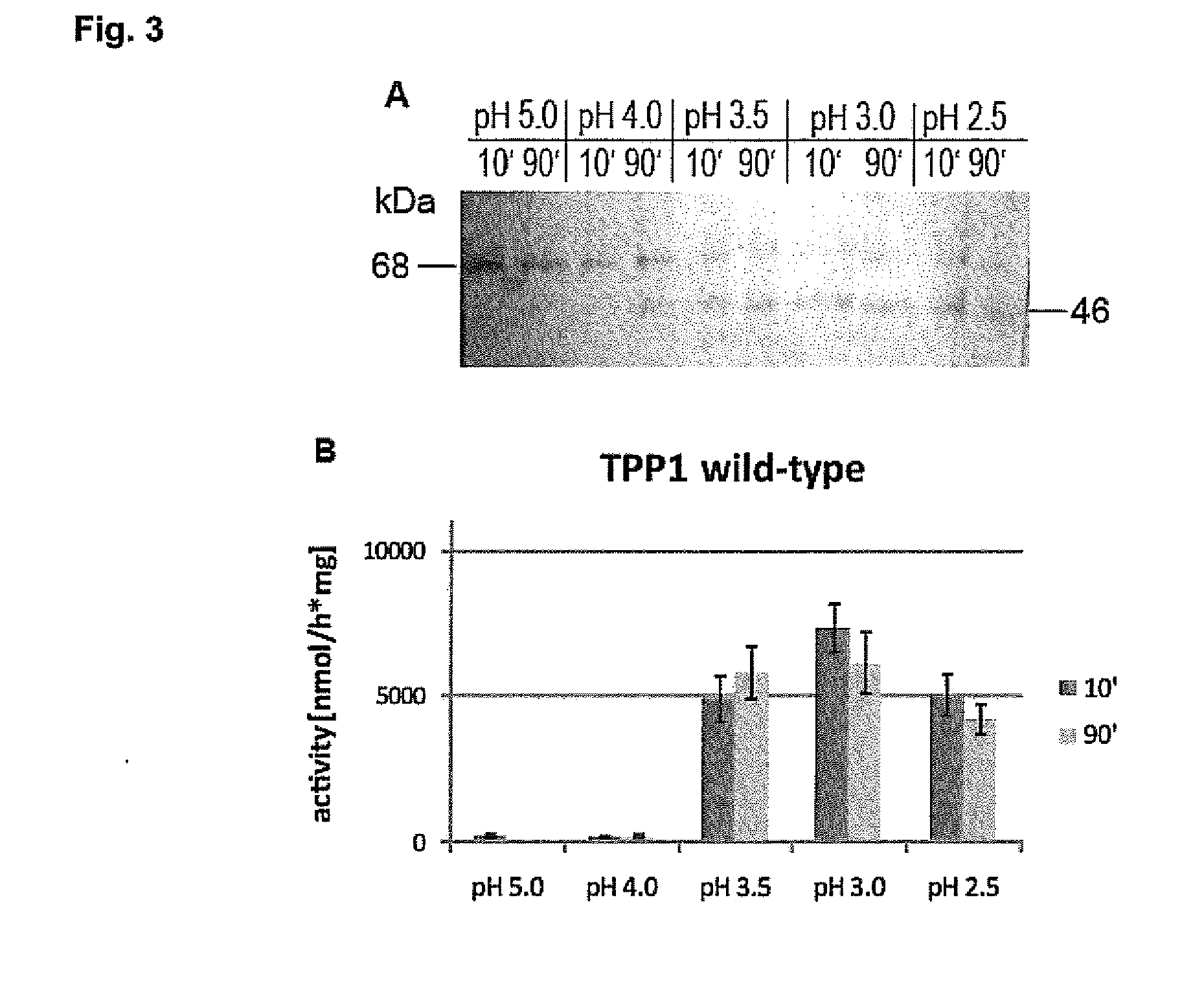Substances and Methods for the Treatment of Lysosmal Storage Diseases
a technology of lysosmal storage and substances, applied in the field of biological and medical science, can solve the problems of low success rate and attempted enzyme replacement therapy, and achieve the effects of improving tpp1 activity, increasing tpp1 auto-processing, and increasing enzymatic activity
- Summary
- Abstract
- Description
- Claims
- Application Information
AI Technical Summary
Benefits of technology
Problems solved by technology
Method used
Image
Examples
example 1
[0140]The medium to be purified is adjusted to a pH-value of 6.0 using a phosphate buffer (final concentration 20 mM; stock solution: KH2PO4, 1 M, pH 4.5 and K2HPO4 1 M pH 9). After centrifugation for 10 min at 40.000 g and 4° C., the medium is filtrated through a 0.2 μm filter and then degassed. The supernatant, having a maximum NaCl concentration of 100 mM, is applied to a cation exchange column (for example Resource S). The flow-through is collected.
[0141]The column is then washed with 10 column volumes of a 20 mM phosphate buffer (pH 6, 100 mM NaCl). A further washing step using an intermediate gradient of 100 to 150 mM NaCl over 5 column volumes is applied. Elution is achieved by applying a linear gradient of 150 to 500 mM NaCl over 20 column volumes (1 ml fractions are collected). A final step of 1 M NaCl over 10 column volumes is applied. UV and salt gradient are monitored during the entire elution process.
[0142]Fractions containing the fusion protein are pooled and adjusted ...
example 2
[0143]The medium is adjusted to a pH of 7.5 using a 20 mM phosphate buffer, centrifuged for 10 min at 40.000 g and 4° C., filtrated through a 0.2 μm filter and then degassed. The supernatant is diluted with 1 volume of 20 mM phosphate buffer (pH 7.5) so that the diluted supernatant has a maximum NaCl concentration of 80 mM. The diluted supernatant is then applied to an anion exchange column (for example Resource Q). The column is subsequently washed with 10 column volumes of phosphate buffer (pH 7.5; 80 mM NaCl) followed by an intermediate NaCl gradient of 80 to 150 mM NaCl over 10 column volumes. For elution, the a linear gradient of 150-500 mM NaCl over 20 column volumes is applied (1 ml fractions are collected, peak between 200-300 mM NaCl) with a subsequent adjustment to 1 M NaCl over 10 column volumes. UV and salt gradient are monitored during the entire elution process.
example 3
[0144]The medium is adjusted to a pH of 7.5 using 20 mM phosphate buffer. The final NaCl concentration is adjusted to 800 mM NaCl. The medium is then centrifuged for 10 min at 40.000 g and 4° C., followed by filtration through a 0.2 μm filter and subsequent degassing. The filtered supernatant is then applied to a Heparin-Sepharose-column (flow rate 1 ml / min), the flow-through is collected.
[0145]Purification is continued by applying 10 column volumes of 20 mM phosphate buffer (pH 7.5, 800 mM NaCl). For elution a linear gradient of 0.8-2 M NaCl over 20 column volumes is applied (1 ml fractions are collected, peak between 1.5 and 1.8 M NaCl), followed by a 2 M NaCl step over 10 column volumes. UV and salt gradient are monitored during the entire elution process.
[0146]After subsequent desalting and buffer exchange to PBS (pH 7.5) using gel filtration or ultrafiltration, the TPP1-FGF2 fusion proteins are aliquoted and stored at −70° C. For further characterisation of the fusion proteins,...
PUM
| Property | Measurement | Unit |
|---|---|---|
| Composition | aaaaa | aaaaa |
Abstract
Description
Claims
Application Information
 Login to View More
Login to View More - R&D
- Intellectual Property
- Life Sciences
- Materials
- Tech Scout
- Unparalleled Data Quality
- Higher Quality Content
- 60% Fewer Hallucinations
Browse by: Latest US Patents, China's latest patents, Technical Efficacy Thesaurus, Application Domain, Technology Topic, Popular Technical Reports.
© 2025 PatSnap. All rights reserved.Legal|Privacy policy|Modern Slavery Act Transparency Statement|Sitemap|About US| Contact US: help@patsnap.com



